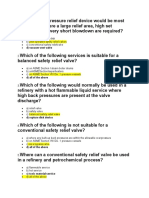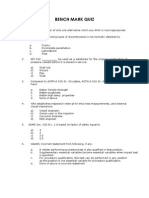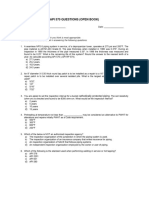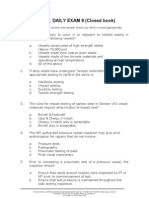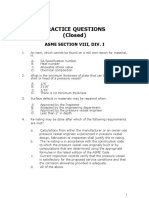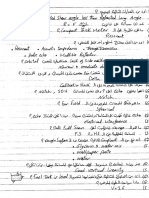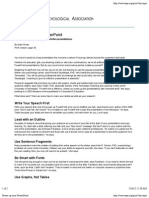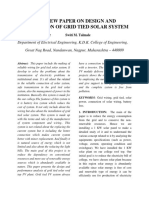Final Exam With Answers
Final Exam With Answers
Uploaded by
Hatem RagabCopyright:
Available Formats
Final Exam With Answers
Final Exam With Answers
Uploaded by
Hatem RagabOriginal Description:
Copyright
Available Formats
Share this document
Did you find this document useful?
Is this content inappropriate?
Copyright:
Available Formats
Final Exam With Answers
Final Exam With Answers
Uploaded by
Hatem RagabCopyright:
Available Formats
C
E
(
C
C
T
I
I
C
O
)
Exam
1. For all repairs and alterations under API 510, the ultimate responsibility rests
with:
a. Owner user
b. API Committee
c.API-510 Inspector
d. Jurisdiction authority
2. Repair Organization is__________ and carries out repairs as per API 510
a. Holder of ASME certificate & appropriate code symbol stamp
b. Owner-user
c.Contractor under contract with owner-user
d.Any of above
3. Repair on pressure vessels will:
a. Restore the vessels to intended (original)design conditions
b. Not change the rating of vessel.
c.
a and b above
d.Restore the vessels to some other usable conditions
4. According to API 510, authorized inspection agency is:
a. Jurisdiction organization
b. Insurance company which under writes insurance of pressure vessels
c.
Inspection organization of owner-user
d.Any of above
5. As per API 510 .. is responsible for design, engineering review, analysis, or
evaluation of pressure vessels and pressure-relieving devices .
a. The Inspector
b. The Owner /User
c.
Repair organization
d. The examiner
6. Who is responsible for engineering review, analysis, or evaluation of pressure
vessels and pressure-relieving devices
a. The Inspector
b. The Engineer
c.The Owner/user
d. The repair organization
7. Who is responsible for the inspection, NDE, and pressure testing activities meet
API 510 requirements
a. The Inspector
b. The Engineer
c.The Owner/user
d. The Examiner
El Serag Mall Towers, Tower No. 2, Entrance No. 3, Flat No.81, Nasr city, Cairo, Egypt
E-mail:i.desoky@cic-egypt.com
E-mail: admin@cic-egypt.com
Web:
www.cic-egypt.com
Mob. 0121 47464749 Mob. 011 484 14 904
Fax: +2 02 26707979
Tel: +2 0226702161
E
(
C
C
T
I
I
C
O
)
8. A RBI assessment determines risk by combining the?
a. Cause and effect
b. Probability and possibility
c.probability and the consequence
d. All of the above
9. The probability assessment should be in accordance with API 580, Section 9,
and must be based on:
a. General and local metal loss
b. Surface connected cracking
c.Metallurgical changes
d. all forms of damage that could reasonably be expected to affect a vessel in any
particular service
10.consequence assessment should be in accordance with API 580, Section 10 and
must consider:
a. the potential incidents that may occur as a result of fluid release
b. the size of a potential release
c.the type of a potential release
d. All of the above
11.When individuals are inside a vessel for an internal inspection :
a. all persons working around the vessel should be informed that people are working inside
the vessel
b. Individuals working inside the vessel should be informed when any work is going to be
done on the vessels exterior
c.The safety officer shall be informed
d. a and b above
12.During internal inspection, When vessels are equipped with removable
internals:
a. internals shall need to be removed, to the extent necessary, to allow inspection of
pressure boundary surfaces
b. The internals need not be removed completely as long as reasonable assurance exists
that damage in regions rendered inaccessible by the internals is not occurring to an
extent beyond that found.
c.Shall be inspected as per the Owner/user requirements
d. Any of the above
13.The inspector, should determine when it is necessary to remove deposits or
linings to perform adequate inspections , he should consult with
a. The Engineer
b. The Owner /User
c.The examiner
d. The corrosion specialist
14.If the lining appears damaged, bulged or cracked
El Serag Mall Towers, Tower No. 2, Entrance No. 3, Flat No.81, Nasr city, Cairo, Egypt
E-mail:i.desoky@cic-egypt.com
E-mail: admin@cic-egypt.com
Web:
www.cic-egypt.com
Mob. 0121 47464749 Mob. 011 484 14 904
Fax: +2 02 26707979
Tel: +2 0226702161
E
(
C
C
T
I
I
C
O
)
a. The lining shall be removed
b. A small portions of the linings may be removed for investigation
c.External NDE techniques may be advisable to explore for damage beneath linings
d. B or c above
15.The On-stream inspection shall be performed by.
a. The Inspector
b. The Owner /User
c.The examiner
d. A or c above
16.thickness inspection may be a part
a. The internal inspection
b. The external inspection
c.The On-stream inspection
d. Any of the above
17.Buried vessels shall be inspected to determine their external surface
condition ,the corrosion rate information obtained from
a. During maintenance activity on similar vessel
b. From the interval examination of similarly buried vessel
c.From representative portions of the actual vessel
d. All of the above
18.When the short term corrosion rate changes significantly from the previous
identified rate
a. The inspector should consult with the corrosion Engineer
b. The inspector should analyze the cause
c.The inspector should report to the owner
d. None of the above
19.Inspection for CUI shall be considered for externally-insulated vessels and
those that are in intermittent service or operate between
a. 10C and 350C for carbon and low alloy steels
b. 140C and 350C for austenitic stainless steels
c.A and B
d. None of the above
20.it is not necessary to remove the insulation for inspection of the vessel
a. If external coverings are in good condition
b. If no evidence of fluid leakage.
c.If Equipment is not in intermittent service
d. All of the above
21.When the service is changed from highly corrosive medium to clean non
corrosive hydrocarbon service
El Serag Mall Towers, Tower No. 2, Entrance No. 3, Flat No.81, Nasr city, Cairo, Egypt
E-mail:i.desoky@cic-egypt.com
E-mail: admin@cic-egypt.com
Web:
www.cic-egypt.com
Mob. 0121 47464749 Mob. 011 484 14 904
Fax: +2 02 26707979
Tel: +2 0226702161
E
(
C
C
T
I
I
C
O
)
a. CMLs may be eliminated or the number significantly reduced
b. The inspector should consult with the engineer
c.A and B
d. None of the above
22.When the owner/user requires the detection of interior surface (ID) breaking
flaws when inspecting from the external surface (OD); .
a.
b.
c.
d.
The
The
The
The
Inspector shall specify industry-qualified UT shear wave examiners
owner/user shall specify industry-qualified UT angle beam examiners
owner/user shall specify industry-qualified UT angle beam examination procedure
examiner shall be qualified and certified
23.Possible sources of UT measurement inaccuracies
a. Improper instrument calibration
b. Excessive rocking of the probe
c. Subsurface material flaws
d. Any of the above
24. Before applying a hydrostatic test
a. the supporting structures and foundation design should be reviewed to assure they
are suitable for the hydrostatic load
b. The Engineer should be consulted
c. The Owner/user shall be informed
d. The repair organization shall provide the water for the test
25. Appropriate NDE shall be specified and conducted when a pressure test is not
performed after a major repair
a. only after the engineer has approved
b. only after the inspector has approved
c. only after the Owner/user has approved
d. a and b
26.Calculate estimated inspection period for external and internal inspection for a
vessel whose remaining life is estimated as 12 years.
a.
b.
c.
d.
Internal = 6 years, external = 10 years
Internal = 6 years, external = 5 years
Internal = 5 years, external = 10 years
None of the above
27.A 2.0 inch thick vessel data-sheet shows MDMT= 50 deg. F. The minimum
pressure-test temperature for Hydro test to be carried out after alteration shall
be:
a. 70 deg F
b. 80 deg. F
c. 60 deg. F
d. None of above
28. A pressure vessel constructed according to ASME Sec VIII Div 1 with shell
thickness 7/8 (Material of Construction SA 387 gr 11 cl.1) is to be repaired by
using insert plates. The requirement of radiography to be incorporated in repair
procedure shall be:.
El Serag Mall Towers, Tower No. 2, Entrance No. 3, Flat No.81, Nasr city, Cairo, Egypt
E-mail:i.desoky@cic-egypt.com
E-mail: admin@cic-egypt.com
Web:
www.cic-egypt.com
Mob. 0121 47464749 Mob. 011 484 14 904
Fax: +2 02 26707979
Tel: +2 0226702161
a.
b.
c.
d.
E
(
C
C
T
I
I
C
O
)
Full radiography
Spot radiography
May be a, or b depending on joint efficiency
Data is not adequate
29. A pressure vessel has been in service for 12 years and has a history of
corrosion over its service life. The original thickness was 1.9375 inches; the
current thickness is 1.405 inches. What is the corrosion rate for this vessel?
a.
b.
c.
d.
0.044
0.089
0.266
0.532
inch
inch
inch
inch
per
per
per
per
year
year
year
year
30. After an inspection interval is completed and if calculations indicate that an
inaccurate rate of corrosion has been assumed initially, how do you determine
the corrosion rate for the next inspection period?
a.
Check the original calculations to find out what the error is in the original
assumption.
b. Unless the corrosion rate is changed by Jurisdiction, the initial rates shall be used.
c. The corrosion rate shall be adjusted to agree with the actual rate found.
d. Call in a corrosion specialist
31. Materials used for making repair by welding in carbon steel vessels shall have
the following limitations?
a.
b.
c.
d.
They shall meet the requirements stipulated in NACE Standard.
The carbon content shall not be over 0.35%
Welding repair shall be done by using only the GTAW process
All of the above
32. Calculate the remaining life and external insp. interval of a vessel given the
following data:
Actual thickness = 0.955 inch
Minimum thickness required = 0.755 inch
Thickness at previous inspection 5 years prior to present inspection = 1.025 inch
a.
b.
c.
d.
20 years, 10 years
14 years, 5years
28 years, 10 years
None of the above
33. Which of the following are commonly preferred to know the process side
degradation of pressure vessels?
a.
b.
c.
On stream inspection.
Internal inspection
External inspection as alternative to internal inspection
El Serag Mall Towers, Tower No. 2, Entrance No. 3, Flat No.81, Nasr city, Cairo, Egypt
E-mail:i.desoky@cic-egypt.com
E-mail: admin@cic-egypt.com
Web:
www.cic-egypt.com
Mob. 0121 47464749 Mob. 011 484 14 904
Fax: +2 02 26707979
Tel: +2 0226702161
d.
E
(
C
C
T
I
I
C
O
)
Any of above is OK
34. Before carrying out an internal service inspection on a vessel put in-service
for quite some time what the inspector should do first
a.
b.
c.
d.
Check
Check
Check
Check
the
the
the
the
material in which it is constructed.
permanent file of the vessel.
progressive history file of the vessel.
original thickness report.
35. For a new vessel the corrosion rate will be established based on:
a.
b.
c.
d.
Run the vessel for 3 or 6 weeks and establish the corrosion rate
Run the vessel for 3 or 6 months and establish the corrosion rate
Run the vessel for 18 weeks and establish the corrosion rate
After 1000 working hours
36. A vessel in service has different zones of corrosion. The next inspection
frequency will be decided by:
a.
b.
c.
d.
37.
Zone with highest rate of corrosion
Zone with lowest remaining life
Average rate of corrosion shall be taken into consideration
To be established for each zone independently
Each vessel above ground shall be given a visual external inspection
preferably while in operation at a frequency of:
a.
b.
c.
d.
At least once in every 5 years
Same as that required for internal or on stream inspection
The lesser of a or b
None of the above are applicable
38. If probable corrosion rates can not be determined, on stream determinations
shall be made after approximately
a.
b.
c.
d.
10,000 hours of service
1000 hours of service
3 to 6 months of service
After 2,500 hours of service
39. Which of the following are essential elements of a Quality control system of a
repair organization?
a.
b.
c.
d.
Organizational authority and responsibility
Statements about Working (Inspection/repair)Procedures and
Statement of controls to ensure Quality conformance
All of the above
their documentation
El Serag Mall Towers, Tower No. 2, Entrance No. 3, Flat No.81, Nasr city, Cairo, Egypt
E-mail:i.desoky@cic-egypt.com
E-mail: admin@cic-egypt.com
Web:
www.cic-egypt.com
Mob. 0121 47464749 Mob. 011 484 14 904
Fax: +2 02 26707979
Tel: +2 0226702161
E
(
C
C
T
I
I
C
O
)
40. Which of the following statements is true?
a.
b.
c.
d.
All defects are not discontinuities
All discontinuities are defects
Discontinuities are rejectable defects
Defects are rejectable discontinuities
El Serag Mall Towers, Tower No. 2, Entrance No. 3, Flat No.81, Nasr city, Cairo, Egypt
E-mail:i.desoky@cic-egypt.com
E-mail: admin@cic-egypt.com
Web:
www.cic-egypt.com
Mob. 0121 47464749 Mob. 011 484 14 904
Fax: +2 02 26707979
Tel: +2 0226702161
You might also like
- 2023 Direct Deposit Tutorials PDFDocument16 pages2023 Direct Deposit Tutorials PDFIsabella Kings93% (14)
- API 510 QUIZ No.4 With AnswersDocument5 pagesAPI 510 QUIZ No.4 With AnswersHatem Ragab100% (2)
- The Location Markers Required by ASME V Are Required To Appear As Radiographic ImagesDocument6 pagesThe Location Markers Required by ASME V Are Required To Appear As Radiographic ImagesSadiq KhattakNo ratings yet
- API 510 Exam 5 ClosedDocument4 pagesAPI 510 Exam 5 Closedweerasinghek100% (1)
- Reminder On Vanilla Interest RatesDocument60 pagesReminder On Vanilla Interest Ratesluong84718No ratings yet
- API 510 Closed 1Document5 pagesAPI 510 Closed 1Einsteinw2No ratings yet
- Api 510 Close Book (Sec Viii & 510) - 17Document12 pagesApi 510 Close Book (Sec Viii & 510) - 17walid walid100% (1)
- API 510 QUIZ No.1Document3 pagesAPI 510 QUIZ No.1Hatem RagabNo ratings yet
- 510 PC Oct04 Qar-Mid Closed PSJDocument12 pages510 PC Oct04 Qar-Mid Closed PSJCss SfaxienNo ratings yet
- Api 653 Preparatory Course: Exam 4 - Closed BookDocument4 pagesApi 653 Preparatory Course: Exam 4 - Closed BookNuwan Ranaweera100% (1)
- API-510 Closed Book (Vérifié Lors Du Test) FLASH CARDSDocument31 pagesAPI-510 Closed Book (Vérifié Lors Du Test) FLASH CARDSfathiNo ratings yet
- Examination Question 510Document12 pagesExamination Question 510ohengjkt100% (1)
- Set-C API 510 Preparatory CourseDocument29 pagesSet-C API 510 Preparatory CourseptssoftNo ratings yet
- API 653 PC 26feb05 Exam Final ClosedDocument8 pagesAPI 653 PC 26feb05 Exam Final ClosedNuwan Ranaweera100% (1)
- Api 576Document13 pagesApi 576BrownNo ratings yet
- API 653 Recertification Test July 2009Document10 pagesAPI 653 Recertification Test July 2009Allau NajuNo ratings yet
- 17 Multiple Choice QuestionsDocument3 pages17 Multiple Choice QuestionsAnonymous Q4YUvR100% (1)
- 572 Study Guide PDFDocument21 pages572 Study Guide PDFRanaweera Ariyamanjula100% (2)
- API 570 - Daily Exam 5C API-571-577 Questions - PSJDocument4 pagesAPI 570 - Daily Exam 5C API-571-577 Questions - PSJKrishna Moorthy50% (2)
- Daily Points To Recall (Day 8) : Page 1 of 3Document3 pagesDaily Points To Recall (Day 8) : Page 1 of 3chowhkNo ratings yet
- Closed Book API 510 Practice Exam ADocument1 pageClosed Book API 510 Practice Exam AAnil KulkarniNo ratings yet
- API 510 PC 20 31 Aug05 Bench MarkDocument4 pagesAPI 510 PC 20 31 Aug05 Bench MarknikafiqNo ratings yet
- API 510 - Book 6Document119 pagesAPI 510 - Book 6nathaniel ekaikoNo ratings yet
- 17 Multiple Choice Questions: No Answer GivenDocument5 pages17 Multiple Choice Questions: No Answer GivenAnonymous Q4YUvRNo ratings yet
- API 572 (Question Answers)Document39 pagesAPI 572 (Question Answers)Muhammad Shoaib100% (2)
- API 570 Model Questions-1 PDFDocument4 pagesAPI 570 Model Questions-1 PDFabdulgafoor54No ratings yet
- FINAL EXAMINATION API 570 Open BookDocument3 pagesFINAL EXAMINATION API 570 Open BookdenarlijeronNo ratings yet
- 1 - 2011 570 Open Book Exam (27Qs)Document7 pages1 - 2011 570 Open Book Exam (27Qs)Sunny Thundil100% (2)
- API 510. DAILY EXAM 9 (Closed Book)Document5 pagesAPI 510. DAILY EXAM 9 (Closed Book)Shanawas Abdul RazakNo ratings yet
- Final Examination #1: Open Book Questions (1 50)Document29 pagesFinal Examination #1: Open Book Questions (1 50)kiho sung100% (1)
- Api 510 Close Book - 4Document20 pagesApi 510 Close Book - 4tayyabNo ratings yet
- API 570 Questions 19Document4 pagesAPI 570 Questions 19Ravindra S. Jivani100% (1)
- 510 IRS Pune Open Book Questions FinalDocument6 pages510 IRS Pune Open Book Questions Finaljaheer1No ratings yet
- 26feb05 4 ClosedDocument5 pages26feb05 4 Closedmitesh100% (1)
- Api 577 Quastion01Document2 pagesApi 577 Quastion01korichiNo ratings yet
- Daily Exam 2A ClosedDocument6 pagesDaily Exam 2A ClosedkhairurNo ratings yet
- 2 - API 570 Exam B (150 Q&A)Document33 pages2 - API 570 Exam B (150 Q&A)Dabbar Taher100% (1)
- Api 570 Practice Questions (Closed Book)Document31 pagesApi 570 Practice Questions (Closed Book)Ravindra S. JivaniNo ratings yet
- Api 578-Mock 1Document27 pagesApi 578-Mock 1sheikmoin100% (1)
- API - RP - 571 - Edited - 42 - Questions - PDF - Filename UTF-8''API RP 571 Edited - 42 QuestionsDocument5 pagesAPI - RP - 571 - Edited - 42 - Questions - PDF - Filename UTF-8''API RP 571 Edited - 42 Questionsأحمد صبحى100% (1)
- API 510 Final Answer Closed Book1Document1 pageAPI 510 Final Answer Closed Book1Nsidibe Michael EtimNo ratings yet
- Api 578-Mock 1 - KeyDocument28 pagesApi 578-Mock 1 - Keysheikmoin100% (1)
- 17 Multiple Choice Questions: No Answer GivenDocument5 pages17 Multiple Choice Questions: No Answer GivenAkram AlhaddadNo ratings yet
- Api 510Document7 pagesApi 510Ranaweera AriyamanjulaNo ratings yet
- API 580 PoliciesDocument4 pagesAPI 580 PoliciesMehmet SoysalNo ratings yet
- Prep Material QB-576Document5 pagesPrep Material QB-576Raheem Khan100% (1)
- API 510 Certification Exam Study Plan PDFDocument3 pagesAPI 510 Certification Exam Study Plan PDFJayeshNo ratings yet
- Api 570 Quiz-2Document34 pagesApi 570 Quiz-2jacquesmayol50% (2)
- RI Appendix 1 Part 5c Radiographic Inspector 1st Edition April 2018Document12 pagesRI Appendix 1 Part 5c Radiographic Inspector 1st Edition April 2018Watsharawee LimpiputtipongNo ratings yet
- API 570 Exame Questions Dated 5 July 2018Document10 pagesAPI 570 Exame Questions Dated 5 July 2018Ahmed ShakirNo ratings yet
- Api 510 QB G-IDocument30 pagesApi 510 QB G-IRanaweera AriyamanjulaNo ratings yet
- API 570 - Refresh - CB - 18 June 2014Document14 pagesAPI 570 - Refresh - CB - 18 June 2014nathan zacky ardamaNo ratings yet
- 570 Sample Questions Rev 061815Document2 pages570 Sample Questions Rev 061815Amal KaNo ratings yet
- Non-Destructive Evaluation of Corrosion and Corrosion-assisted CrackingFrom EverandNon-Destructive Evaluation of Corrosion and Corrosion-assisted CrackingRaman SinghNo ratings yet
- API 510 QUIZ No.3Document6 pagesAPI 510 QUIZ No.3Hatem Ragab0% (1)
- API 510 Questions Amp Answers Closed Book 1 PDF FreeDocument12 pagesAPI 510 Questions Amp Answers Closed Book 1 PDF Freejakariya100% (2)
- API - 510 Exam - 5 - ClosedDocument4 pagesAPI - 510 Exam - 5 - Closedsiraj.hoteccNo ratings yet
- API 510 Flash Cards - 30 TermsDocument8 pagesAPI 510 Flash Cards - 30 Termshahah100% (1)
- Api 510 Preparatory Bench Mark Quiz: AppropriateDocument120 pagesApi 510 Preparatory Bench Mark Quiz: AppropriateCss Sfaxien100% (1)
- API 510 572 576 Questions AnswersDocument33 pagesAPI 510 572 576 Questions Answersnikafiq100% (7)
- API 510 Closed 4Document9 pagesAPI 510 Closed 4Mohammed ShakilNo ratings yet
- Practice Questions (Closed) : Asme Section Viii, Div. IDocument30 pagesPractice Questions (Closed) : Asme Section Viii, Div. Ikorichi100% (3)
- API 510 PC 4sept04 Daily Exam 5 Closed PSJDocument12 pagesAPI 510 PC 4sept04 Daily Exam 5 Closed PSJMohammed Shakil100% (1)
- Intumescent Method Statement - UGDC - R00 11Document1 pageIntumescent Method Statement - UGDC - R00 11Hatem RagabNo ratings yet
- Influence of Heat Input and Post-Weld Heat Treatment On Boiler Steel P91 (9Document10 pagesInfluence of Heat Input and Post-Weld Heat Treatment On Boiler Steel P91 (9Hatem RagabNo ratings yet
- P91 Welding and PWHT ProcedureDocument4 pagesP91 Welding and PWHT ProcedureHatem Ragab100% (2)
- WPS PQR Checklist 2014Document2 pagesWPS PQR Checklist 2014Sebastian Rajesh100% (1)
- Welding Interview Question His Answers GuideDocument8 pagesWelding Interview Question His Answers GuideHatem RagabNo ratings yet
- Fu/ e ,'. C-.J Ef GK"-T, F SUDocument1 pageFu/ e ,'. C-.J Ef GK"-T, F SUHatem RagabNo ratings yet
- Dear SirDocument1 pageDear SirHatem RagabNo ratings yet
- Magnetic Test: Client: Gas Filling Company (GFC) ContractorDocument1 pageMagnetic Test: Client: Gas Filling Company (GFC) ContractorHatem RagabNo ratings yet
- Level III Responsibilities According To ASNTDocument1 pageLevel III Responsibilities According To ASNTHatem RagabNo ratings yet
- Large GapDocument1 pageLarge GapHatem RagabNo ratings yet
- Hydrostatic Test Procedure For Site & Commissioning HT-031-R1Document7 pagesHydrostatic Test Procedure For Site & Commissioning HT-031-R1Hatem Ragab100% (1)
- DCTR : - Prhe Ah, M,,HBTZ T+WZDocument1 pageDCTR : - Prhe Ah, M,,HBTZ T+WZHatem RagabNo ratings yet
- Ut Report Data For Upper Part 10-9-2016Document3 pagesUt Report Data For Upper Part 10-9-2016Hatem RagabNo ratings yet
- API 510 QUIZ No.4Document5 pagesAPI 510 QUIZ No.4Hatem RagabNo ratings yet
- API 510 QUIZ No.3Document6 pagesAPI 510 QUIZ No.3Hatem Ragab0% (1)
- P4a-MT-103, Rev.3Document67 pagesP4a-MT-103, Rev.3Hatem RagabNo ratings yet
- Wika CPB3800 DatasheetDocument9 pagesWika CPB3800 DatasheetHatem RagabNo ratings yet
- Introduction To The Fundamentals of AccountingDocument72 pagesIntroduction To The Fundamentals of AccountingAna Marie ValenzuelaNo ratings yet
- Module 7 Exercises Problem No. 1Document3 pagesModule 7 Exercises Problem No. 1Ariel Gamboa100% (1)
- Laser Head g6f 25-28-200 Qbh100 CVWDocument1 pageLaser Head g6f 25-28-200 Qbh100 CVWXuan Phuong HuynhNo ratings yet
- Problema 5.34 TaylorDocument7 pagesProblema 5.34 Taylorcerobr15No ratings yet
- Compact Track Loader: Specifications FeaturesDocument4 pagesCompact Track Loader: Specifications Featuresluismdmj100% (1)
- English Project - Spider Man Into The Spider VerseDocument39 pagesEnglish Project - Spider Man Into The Spider VerseSiddhi Khandelwal100% (2)
- Emed ES300 Operation ManualDocument30 pagesEmed ES300 Operation Manualhany madcorNo ratings yet
- Enbaling Out Comes 6 (Hbo)Document2 pagesEnbaling Out Comes 6 (Hbo)Nabongs AegyooNo ratings yet
- Test 1: Gerunds and Infinitives / Test 1 (42 Adet Soru) Eskişehir YesdđlDocument4 pagesTest 1: Gerunds and Infinitives / Test 1 (42 Adet Soru) Eskişehir YesdđlTayanc Andy AkgünNo ratings yet
- 1993 National Mechanical Code PDFDocument129 pages1993 National Mechanical Code PDFHarley OspinaNo ratings yet
- Philippine Journal of Development: Stock Market Development in The Philippines: Past & PresentDocument2 pagesPhilippine Journal of Development: Stock Market Development in The Philippines: Past & PresentamerahNo ratings yet
- 24 - Excavation and Trenching Procedure V2.0 PDFDocument46 pages24 - Excavation and Trenching Procedure V2.0 PDFUthaya KumarNo ratings yet
- Rcep AssignmentDocument5 pagesRcep AssignmentNageeta BaiNo ratings yet
- Power Up Your PowerPointDocument2 pagesPower Up Your PowerPointddb5013No ratings yet
- A Review Paper On Design and Installtion of Grid Tied Solar SystemDocument4 pagesA Review Paper On Design and Installtion of Grid Tied Solar Systemswiti talmaleNo ratings yet
- How To Create Your First Board GameDocument157 pagesHow To Create Your First Board GameAlexandre PitaNo ratings yet
- Naam Newsletter 2002 06Document8 pagesNaam Newsletter 2002 06api-241335034No ratings yet
- Neuron and Glial CellsDocument8 pagesNeuron and Glial CellsMurilo Bonet100% (1)
- New ResumeDocument2 pagesNew ResumeKevin BowersNo ratings yet
- Tenderise Beef For Stir FriesDocument12 pagesTenderise Beef For Stir FriestakudzwanjowaNo ratings yet
- AD7730 - EngineerZone PDFDocument23 pagesAD7730 - EngineerZone PDFAslam AhamedNo ratings yet
- Fun Memory GameDocument2 pagesFun Memory GameHuma RiazNo ratings yet
- MPX2053 MPXV2053G DatasheetDocument12 pagesMPX2053 MPXV2053G DatasheetkurmakkNo ratings yet
- ADR FormDocument1 pageADR Formultimate_2226252No ratings yet
- Antimatter: The Physics of Atomic and Molecular InteractionsDocument2 pagesAntimatter: The Physics of Atomic and Molecular InteractionsArc AngleNo ratings yet
- Ansulite Afc3B-Fp29 3% Freeze-Protected AFFF Concentrate: DescriptionDocument2 pagesAnsulite Afc3B-Fp29 3% Freeze-Protected AFFF Concentrate: DescriptionDavid CubaNo ratings yet
- Unoct - ONU ANTITERRORISMO - Mar2021Document2 pagesUnoct - ONU ANTITERRORISMO - Mar2021RocioNo ratings yet
- FACTs Controllers NotesDocument17 pagesFACTs Controllers NotesrajashekarmandiNo ratings yet














